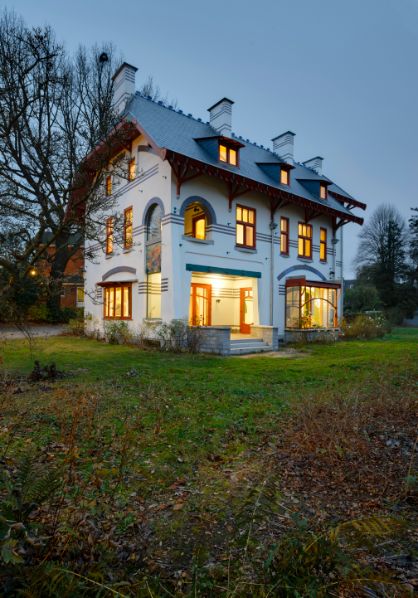Inside Belgian Modernism: 1st Lecture by Xavier Folville
LECTURE + drink | Tuesday 29.09.2015, 19:30 | KULeuven Faculty of Architecture, Brussels

Villa L’Aube. Vue sud-ouest, depuis le jardin (photo © JL Deru photo-daylight.com)
Inside Belgian Modernism: 1st lecture by Xavier Folville, ULg (FR)
EN – Tuesday 29 September, 19:30
Xavier Folville of the University of Liège will speak about the relation between (interior) architecture, the decorative arts and industrialism. The lecture in French is entitled The Architect Gustave Serrurier-Bovy (1858-1910) and is held at:
KULeuven Faculty of Architecture in Brussels | 1030 Brussel, Rue des Palais / Paleizenstraat 65-67, Auditorium
Entrance: members & students free, non-members €5; please register online
NL – Dinsdag 29 september, 19:30
Xavier Folville van de Universiteit van Luik zal het hebben over de relatie tussen (interieur)architectuur, de decoratieve kunsten en het industriële. De lezing in het Frans is getiteld: L’architecte Gustave Serrurier-Bovy (1858-1910) en gaat door aan de:
Faculteit Architectuur KU Leuven in Brussel | 1030 Brussel, Paleizenstraat 65-67 Auditorium
Inkom: leden & studenten gratis, niet-leden €5; graag online inschrijven
FR – Mardi 29 septembre, 19:30
Xavier Folville de l’Université de Liège abordera la relation entre architecture d’intérieur, arts décoratifs et arts industriels. Le conférence en français sous le titre L’architecte Gustave Serrurier-Bovy (1858-1910) aura lieu à:
Faculté d’architecture KU Leuven à Bruxelles | rue des Palais 65-67, 1030 Schaerbeek, Auditoire
Entrée: membres & étudiants gratuit, non-membres €5; inscrire en ligne s’il vous plaît
Read more (EN) / lees verder (NL) / en savoir plus (FR) about the lecture series “Inside Belgian Modernism”

Villa L’Aube. De la salle à manger vers le salon (photo © JL Deru photo-daylight.com)
EN
The Architect Gustave Serrurier-Bovy (1858-1910)
Architect by vocation and formation, then merchant, and after that designer and industrialist, Gustave Serrurier, aka Serrurier-Bovy, is mostly known as a producer of furniture. Although more marginal, his architectural work are far from negligible. After 1888, and a couple of youthful projects, the architect from Liège most probably only does interior furnishings, but these prove to be considerable. For example, he brilliantly remodels the space and interior organization of the castle of La Cheyrelle (1903-1909) in the Cantal region of France. Just before, in 1902, he draws again the plans of an entire villa – his personal villa – which seems to function as a manifesto for an architecture different from Art Nouveau. Theoretician and utopian, he also develops a social reflection which leads him to think that architecture and furniture are interconnected practices, particularly apt to better the conditions of existence, notably of the less healthy. He applies and shows it in the furnishings of a workers housing complex in a competition organized on the occasion of the Liège World’s Fair in 1905. In his built work, through his spatial inventions and his sober and functional decoration, Serrurier opens perspectives onto a new art of life in the 20th century, and he anticipates thus the social, technical and artistic preoccupations of the Modern Movement.
read more about Xavier Folville
NL
L’architecte Gustave Serrurier-Bovy (1858-1910)
Architect uit roeping en vorming, dan handelaar, vervolgens ontwerper en industrieel, Gustave Serrurier, alias Serrurier-Bovy, is vooral gekend als meubelproducent. Hoewel eerder marginaal, is zijn architecturale oeuvre verre van verwaarloosbaar. Na 1888, en enkele jeugdwerken, lijkt het er op dat de Luikse architect enkel binnenhuisprojecten uitvoert, maar deze blijken aanzienlijk te zijn. Bijvoorbeeld remodelleert hij op briljante wijze de ruimte en interne organisatie van het kasteel van La Cheyrelle (1903-1909) in de Franse Cantalstreek. Juist daarvoor, in 1902, maakt hij opnieuw bouwplannen op voor een volledige villa – zijn persoonlijke villa – die overkomt als een manifest voor een andere architectuur dan de Art Nouveau. Als theoreticus en utopist ontwikkelt hij ook een sociale reflectie, die hem ertoe leidt architectuur en meubelkunst op te vatten als verbonden praktijken, in het bijzonder geschikt om de levensomstandigheden te verbeteren, vooral van de minder gezonden. Hij past dit ook toe en toont het aan in de inrichting van arbeiderswoningen tijdens een ontwerpwedstrijd georganiseerd naar aanleiding van de Wereldtentoonstelling van 1905 in Luik. In zijn gebouwde werk, door zijn ruimtelijke inventies en zijn terughoudende en functionele decoratie, opent Serrurier perspectieven naar een nieuwe levenskunst voor de 20e eeuw, en zo anticipeert hij op de sociale, technische en artistieke bekommernissen van de Moderne beweging.
Lees meer over Xavier Folville.
FR

Villa L’Aube. La cage d’escalier et la coursive (photo © JL Deru photo-daylight.com)
L’architecte Gustave Serrurier-Bovy (1858-1910)
Architecte par vocation et formation, puis commerçant, ensuite créateur et industriel, Gustave Serrurier, dit Serrurier-Bovy, est surtout connu pour sa production de mobilier. Plus marginal, son travail d’architecte est pourtant loin d’être négligeable. Au-delà de 1888, après quelques œuvres de jeunesse, l’architecte liégeois ne réalise sans doute plus que des aménagements d’intérieurs, mais ceux-ci peuvent s’avérer considérables. Par exemple, il remodèle brillamment l’espace et la distribution intérieure du château de La Cheyrelle (1903-1909) dans le Cantal, en France. Juste avant, en 1902, on le voit dresser à nouveau les plans complets d’une villa – sa villa personnelle – qui sonne alors comme un manifeste pour une architecture différente de l’Art nouveau. Théoricien et utopiste, il développe aussi une réflexion sociale qui le conduit à penser qu’architecture et mobilier sont des pratiques liées, particulièrement propres à améliorer les conditions de l’existence, notamment des moins nantis. Il le prouve et l’expérimente encore dans l’aménagement d’un logement ouvrier lors du concours organisé à l’occasion de l’Exposition universelle de Liège en 1905. Dans son œuvre construite, par ses inventions spatiales, par sa décoration retenue et fonctionnelle, Serrurier ouvre des perspectives sur un nouvel art de vivre au 20e siècle et anticipe les préoccupations sociales, techniques et artistiques du Mouvement moderne.
With the support of:
Design Museum Gent, University Antwerp Faculty of Design Sciences, KULeuven Faculty of Architecture, Design Flanders
Stichting Interieur
25th international Biennale Interieur
14-23 October 2016 Kortrijk, Belgium




